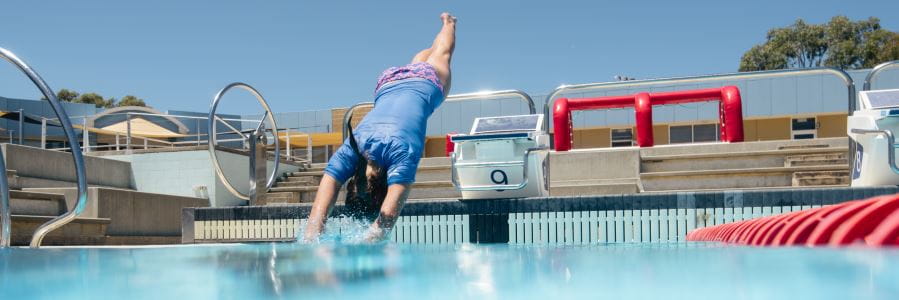
While diving is an important skill for students to learn, it can become dangerous if done incorrectly.
Teaching techniques
Teachers of swimming and water safety education should equip students with the skills and understanding needed to perform a dive. All students should be aware of the potential dangers and encouraged to only dive into clear water that is free from any obstructions and only when the water depth is known to be sufficient for diving.
To ensure the safest possible dive when teaching it is important to instruct the students to ‘lock hands, lock head and steer up’.
Locking their hands one on top of the other, with the thumb and little finger of the top hand wrapped over the bottom hand, prevents the hands being forced apart when they hit the water and, in turn, protects the head and neck from any unexpected impact.
Diving safety is further enhanced when the head is squeezed between the outstretched arms, with enough pressure from the arms to ensure the head is locked in this position. This helps to ensure the neck and spine are aligned and protected as much as possible.
‘Steering up’ refers to students using body and limb angles, so their pathway is towards the surface. This should be done as soon as the student enters the water, so the maximum depth reached is decreased along with the risk of impact with the bottom of the pool. To aid steering up towards the surface students should bend back the hands at the wrists, arch the back and lift the arms and head.
There are many progressions that can be taught to ensure safer diving, some of these include:
- Push to glide – Students adopt the ‘lock hands, lock head’ position while in the water, then completely submerge and push off from the wall.
- Push to glide, steering up – Using the push to glide skill, students steer upwards towards the surface after pushing off from the wall. Encourage students to maintain their dive position until their hands break the water surface. Hoops can also be used at this stage to highlight the pathway the student should be taking and add a sense of fun to the skill.
- Sitting dive – Students sit on the pool edge with their feet against the pool wall. They lock their hands and head and dive into the water. Students' feet should push back against the pool wall when they dive to prepare them for the next progressions and to discourage deep diving.
- Crouching dive - Students crouch on the pool edge with one foot forward and one foot back, curling the toes of the front foot over the edge. Weight is transferred from the back foot to the front foot as the students ‘tip’ forward into the water, pushing against the pool edge with their toes. Once the students enter the water the steering-up technique should be used. As students gain confidence with this, encourage the feet to be placed together, with the toes of both feet curled over the pool edge.
Safe diving depths
The Guidelines for Safe Pool Operations (GSPO) specify a minimum depth of 1.5 metres, with an optimum depth of 2 metres, for the teaching of crouching and standing dives.
In lanes with starting blocks, the minimum depth for recreational use is 2 metres.